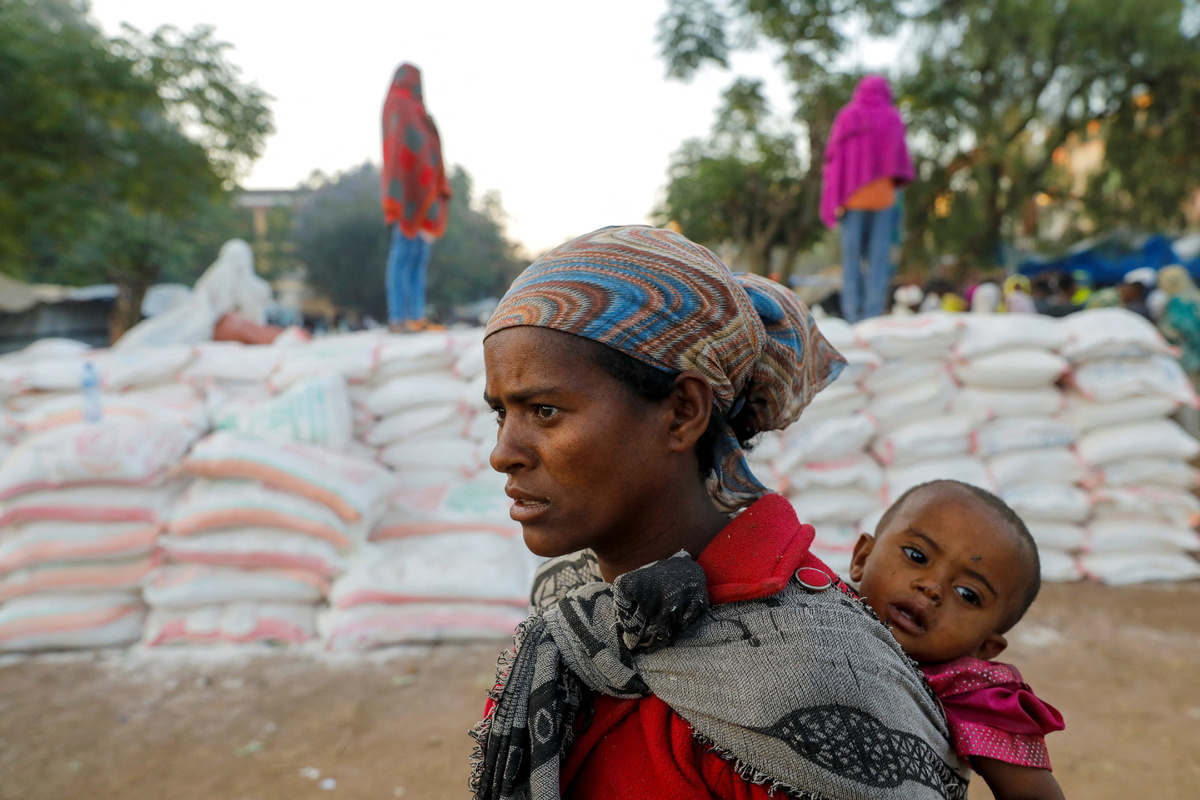Contraception vital regardless of population trends
Contraception vital regardless of population trends - Chinadaily.com ... China Daily


World Contraception Day: Ensuring Access to Contraception for Sustainable Development
A woman carries an infant as she queues in line for food, at the Tsehaye primary school, which was turned into a temporary shelter for people displaced by conflict, in the town of Shire, Tigray region, Ethiopia, March 15, 2021. [Photo/Agencies]

Introduction:
Despite the progress made over the last decade to increase access to contraception, World Contraception Day on September 26 provides an opportunity to highlight the needs of the 257 million women around the world who want to avoid or delay pregnancy and yet are not using a safe, modern method of contraception. By 2030, this number could rise to 271 million because contraceptive services are not keeping pace with rapid population increases in developing countries.
The Importance of Contraception for Sustainable Development:
Contraception is not only relevant in countries with high population growth but also in countries with very low or ultra-low fertility rates. Regardless of population size or trends, access to contraception is a fundamental human right and plays a crucial role in sexual and reproductive health, gender equality, and socioeconomic development in any society.
International Conference on Population and Development:
Next year marks the 30th anniversary of the first International Conference on Population and Development held in Cairo in 1994. During this conference, 179 governments adopted the ICPD Programme of Action, which recognized people’s right to decide when, if, and how many children they have. To ensure this right, it is essential for all women and their partners to have access to high-quality counseling and their preferred contraceptive method.
Social and Economic Factors Influencing Contraceptive Choices:
Contraception empowers women and their partners to make choices about family size. Research shows that various social and economic factors influence decisions regarding having no or fewer children. These factors include rising costs of housing and education, work-life balance challenges, lack of affordable childcare, and gender norms that disproportionately burden women with domestic work and childcare responsibilities.
Addressing Low Fertility Rates:
Purposely restricting access to contraception as a government response to declining fertility rates is ineffective and can have negative consequences. Instead, governments should focus on reducing barriers to parenthood, improving family life, and addressing gender inequality. Policies such as providing high-quality, affordable childcare, flexible work hours, and paid parental leave can support individuals in having the desired number of children.
The Risk of Deprioritizing Contraception:
Even in countries where access to contraception is not formally restricted, there is a risk that governments concerned about declining fertility rates may shift their attention away from contraception towards family-support policies. This can lead to a decrease in investment across the supply chain, resulting in limited access to contraceptives for women and adolescent girls.
The Benefits of Contraception:
Access to contraception is essential for women’s reproductive health and economic well-being. It allows couples to make informed decisions about the spacing of births, which has both health and economic advantages. Additionally, contraception enables women and their partners to decide the total size of their family, providing them with the freedom to conceive or not conceive based on their preferences.
Empowering Adolescents and Young Adults:
Contraception plays a vital role in enabling adolescents and young adults to manage their reproductive choices. By increasing awareness of contraception through age-appropriate sexuality education and ensuring access to high-quality, non-judgmental health services, unintended pregnancies can be prevented, reducing the need for abortion.
Conclusion:
Contraception remains as important today as it was 30 years ago. By implementing the right policies and making necessary investments, we can build thriving and inclusive societies, regardless of population size. Universal access to safe and effective contraception is crucial for the health, well-being, and empowerment of women and girls to make choices about their own bodies and lives.
The author is representative of the United Nations Population Fund in China. The views don’t necessarily reflect those of China Daily.
If you have a specific expertise or would like to share your thoughts about our stories, then send us your writings at opinion@chinadaily.com.cn and comment@chinadaily.com.cn.
SDGs, Targets, and Indicators
| SDGs | Targets | Indicators |
|---|---|---|
| SDG 3: Good Health and Well-being | 3.7: By 2030, ensure universal access to sexual and reproductive health-care services, including for family planning, information and education, and the integration of reproductive health into national strategies and programs | Indicator 3.7.1: Proportion of women of reproductive age (aged 15-49 years) who have their need for family planning satisfied with modern methods |
| SDG 5: Gender Equality | 5.6: Ensure universal access to sexual and reproductive health and reproductive rights as agreed in accordance with the Programme of Action of the International Conference on Population and Development and the Beijing Platform for Action and the outcome documents of their review conferences | Indicator 5.6.1: Proportion of women aged 15-49 years who make their own informed decisions regarding sexual relations, contraceptive use, and reproductive health care |
| SDG 10: Reduced Inequalities | 10.2: By 2030, empower and promote the social, economic, and political inclusion of all, irrespective of age, sex, disability, race, ethnicity, origin, religion, or economic or other status | Indicator 10.2.1: Proportion of people living below 50 percent of median income, by age, sex, and persons with disabilities |
| SDG 11: Sustainable Cities and Communities | 11.3: By 2030, enhance inclusive and sustainable urbanization and capacity for participatory, integrated, and sustainable human settlement planning and management in all countries | Indicator 11.3.1: Ratio of land consumption rate to population growth rate |
1. Which SDGs are addressed or connected to the issues highlighted in the article?
SDG 3: Good Health and Well-being
The article discusses the importance of access to contraception for women’s sexual and reproductive health. It highlights the need for universal access to contraception services, which aligns with SDG 3’s goal of ensuring good health and well-being for all.
SDG 5: Gender Equality
The article emphasizes that access to contraception is a fundamental human right and plays a crucial role in promoting gender equality. It mentions the importance of women and their partners being able to make informed decisions about their reproductive health, which aligns with SDG 5’s goal of achieving gender equality and empowering all women and girls.
SDG 10: Reduced Inequalities
The article discusses the socioeconomic factors that influence women’s decisions about family size, such as rising costs of housing and education, unequal burden of domestic work, and gender norms. Addressing these factors and reducing barriers to parenthood is essential for achieving SDG 10’s goal of reducing inequalities.
SDG 11: Sustainable Cities and Communities
The article mentions the importance of introducing policies and investments that reduce barriers to parenthood and improve family life. This aligns with SDG 11’s goal of enhancing inclusive and sustainable urbanization and human settlement planning.
2. What specific targets under those SDGs can be identified based on the article’s content?
– Target 3.7: By 2030, ensure universal access to sexual and reproductive health-care services, including for family planning, information and education, and the integration of reproductive health into national strategies and programs.
– Target 5.6: Ensure universal access to sexual and reproductive health and reproductive rights as agreed in accordance with the Programme of Action of the International Conference on Population and Development and the Beijing Platform for Action and the outcome documents of their review conferences.
– Target 10.2: By 2030, empower and promote the social, economic, and political inclusion of all, irrespective of age, sex, disability, race, ethnicity, origin, religion, or economic or other status.
– Target 11.3: By 2030, enhance inclusive and sustainable urbanization and capacity for participatory, integrated, and sustainable human settlement planning and management in all countries.
3. Are there any indicators mentioned or implied in the article that can be used to measure progress towards the identified targets?
– Indicator 3.7.1: Proportion of women of reproductive age (aged 15-49 years) who have their need for family planning satisfied with modern methods.
– Indicator 5.6.1: Proportion of women aged 15-49 years who make their own informed decisions regarding sexual relations, contraceptive use, and reproductive health care.
– Indicator 10.2.1: Proportion of people living below 50 percent of median income, by age, sex, and persons with disabilities.
– Indicator 11.3.1: Ratio of land consumption rate to population growth rate.
These indicators can be used to measure progress towards ensuring universal access to contraception, promoting gender equality in reproductive health decision-making, reducing socioeconomic inequalities, and enhancing inclusive and sustainable urbanization.
4. SDGs, Targets, and Indicators
| SDGs | Targets | Indicators |
|---|---|---|
| SDG 3: Good Health and Well-being | 3.7: By 2030, ensure universal access to sexual and reproductive health-care services, including for family planning, information and education, and the integration of reproductive health into national strategies and programs | Indicator 3.7.1: Proportion of women of reproductive age (aged 15-49 years) who have their need for family planning satisfied with modern methods |
| SDG 5: Gender Equality | 5.6: Ensure universal access to sexual and reproductive health and reproductive rights as agreed in accordance with the Programme of Action of the International Conference on Population and Development and the Beijing Platform for Action and the outcome documents of their review conferences | Indicator 5.6.1: Proportion of women aged 15-49 years who make their own informed decisions regarding sexual relations, contraceptive use, and reproductive health care |
| SDG 10: Reduced Inequalities | 10.2: By 2030, empower and promote the social, economic,
Behold! This splendid article springs forth from the wellspring of knowledge, shaped by a wondrous proprietary AI technology that delved into a vast ocean of data, illuminating the path towards the Sustainable Development Goals. Remember that all rights are reserved by SDG Investors LLC, empowering us to champion progress together. Source: global.chinadaily.com.cn
Join us, as fellow seekers of change, on a transformative journey at https://sdgtalks.ai/welcome, where you can become a member and actively contribute to shaping a brighter future.
|








